Threatt Filling Station and Family Farm
As Route 66 left Joplin, Missouri, it was only a short distance westbound thru extreme southeast Kansas to the Oklahoma border. It quickly entered Commerce, and headed southwest through Miami, Afton, Chelsea, Claremore and Tulsa. The road continued west through Sapulpa, Davenport, Chandler and into the town of Luther.
Map of Historic Route 66 showing the location of Luther, Oklahoma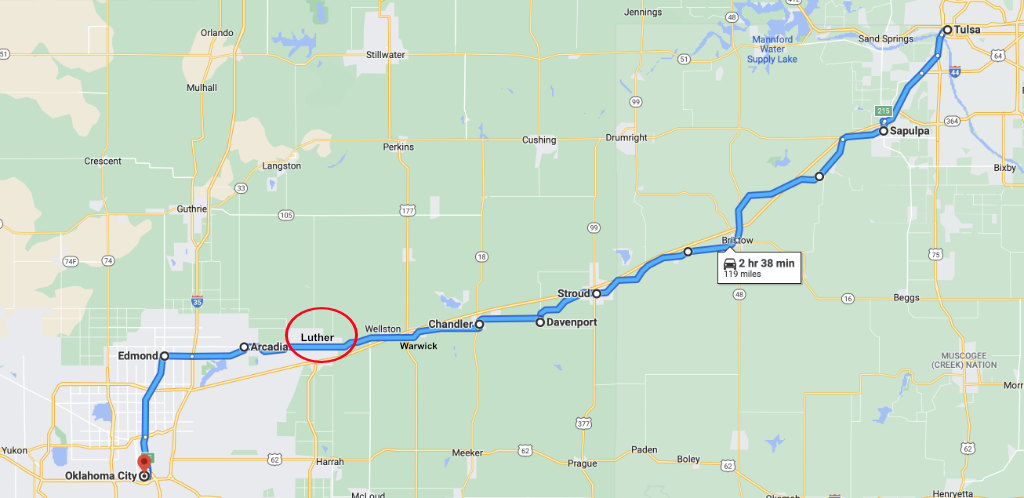 |
History of the Station and FarmAlong with other African Americans, the Threatt families settled in Luther, Oklahoma, after the area opened for homesteading in 1889. Allen Threatt, a homesteader who came from Alabama in the early 1900s, owned 160 acres of land near the small town of Luther, about 25 miles northeast of Oklahoma City. On the farm, he had cows, and raised rabbits, chickens and produce. In addition to farming, Allen quarried local stone from the family property, and built a gas station in 1915 on the northern edge of the property, on the south side of Route 7. The station's outer walls were constructed using native sandstone from the Threatt land. The structure is an outstanding example of Oklahoma's vernacular commercial architecture, in the Bungalow / Craftsman style. Allen's station capitalized on the highway traffic, where he not only sold gas but also produce from his farm. His location became even busier in 1926, when the State Highway 7 became part of the federal government's new U.S. Route 66.
The Threatt Filling Station, according to many Route 66 historians, was the only Black-owned and -operated gas station on the Mother Road during the Jim Crow era. This guaranteed that many Black travelers would stop there, because they weren't always welcomed at other businesses along the way in "sundowner" towns. The station offered African Americans a place to purchase food and fuel, as well as an opportunity for a safe resting place from their travels during times when segregation was still in place. It provided a variety of services, including gasoline, oil, automotive accessories, groceries, cold beer, fixing flats, and oil changes. The station served not only travelers, but also locals from many miles around, who did not need to travel to Edmund or Oklahoma City for goods and produce. Focused on ensuring their safety, African Americans used "The Negro Motorist Green-Book" to find businesses, such as motels, restaurants, diners, and gas stations, that they could patronize during road trips on Route 66 and other highways. The book was published annually from 1936 to 1964 by Victor H. Green, a New York City postal worker. While the Threatt Filling Station was not listed in the Green Book, the site still served as a well-known place of refuge in Oklahoma. The station was also home to the Threatt family, with living quarters on the back side of the business. Next door to the filling station the family would later open a restaurant, known as the "Brown Bomber" after boxer Joe Lewis. The land behind the station served as an area where patrons could park and sleep safely in their automobiles at night. A full-size baseball field was also set up, and many games from teams of the Negro League played there. The family land also served as a place for the Black community to gather for holidays, Easter egg hunts, Fourth of July celebrations, and weekend dances. The family has confirmed that the first structure on this site burned in a fire and was rebuilt about 1933. The filling station supported Threatt's eleven children and made him one of the most successful and respected businessmen in the area. The local newspaper reported that "silence fell on the whole community" when he died on December 8, 1950, at age 61. After Allen Sr. passed, his son Ulysses Grant Threatt took over the filling station until his passing in 1956. It remained opened until the 1970s. The Threatt family still owns the land, and is working to restore the station into an interpretive center. Among the leaders of the restoration efforts are Edward Threatt and Rev. Allen Threatt Ill, under the auspices of the Threatt Filling Station Foundation. Allen has been quoted as saying about the restoration ... "The goal, just as the original goal of the Threatt Filling Station, is to open the doors to anyone and everyone, regardless of race, color or creed. A hope that one day new generations can learn from the mistakes of the past so they can work together for a better future". LocationThe historic Threatt Filling Station is located at the intersection of Route 66 and Pottawatomie Road (3290), about 3 miles east of Luther, Oklahoma. See interactive map of the Station below on this page.
Current Status and RestorationThe National Trust for Historic Preservation has included the Threatt Filling Station and Threatt Family Farm on its list of the 11-Most Endangered Places in America. It is listed on the National Register of Historic Places, and significant restoration work has been completed.
For more information about the history of the station and the family, visit ...
More information about restoration efforts and progress
|
Interactive Map of the Historic Threatt Filling Station
MORE OKLAHOMA ROUTE 66 |
||
 |
 |
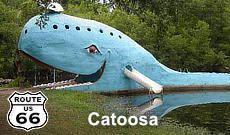 |
 |
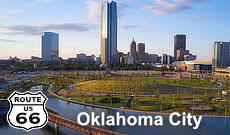 |
 |
 |
 |
 |
 |
 |
 |
 |
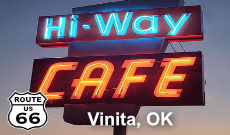 |
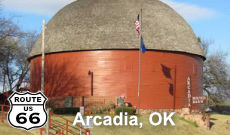 |
 |
||
More About Travel in Oklahoma
More Things to Do on Route 66 - at the Oklahoma Tourism Department
Travel Guides for Other States Along Route 66
Planning a Road Trip on Route 66? Here are trip planners for all eight states on The Mother Road ...
 |
 |
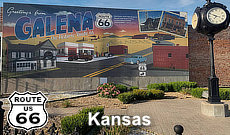 |
 |
 |
 |
 |
 |








